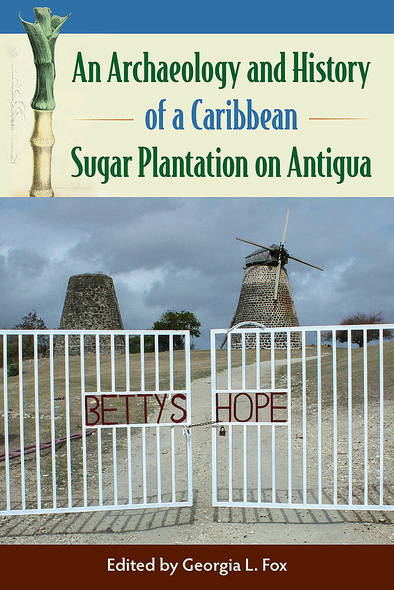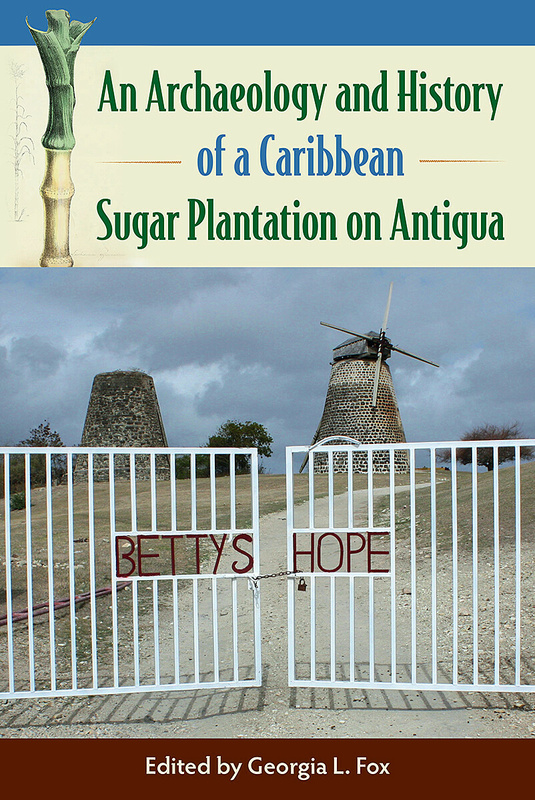
An Archaeology and History of a Caribbean Sugar Plantation on Antigua
This volume uses archaeological and documentary evidence to reconstruct daily life at Betty’s Hope plantation on the island of Antigua, one of the largest sugar plantations in the Caribbean. It demonstrates the rich information that the multidisciplinary approach of contemporary historical archaeology can offer when assessing the long-term impacts of sugarcane agriculture on the region and its people. Drawing on ten years of research at the 300-year-old site, the researchers uncover the plantation’s inner workings and its connections to broader historical developments in the Atlantic World. Excavations at the Great House reveal similarities to other British colonial sites, and historical records reveal the owners’ involvement in the Atlantic slave trade and in the trade of rum and other commodities. Artifacts uncovered from the slave quarters—ceramic tokens, repurposed bottle glass, and hundreds of Afro-Antiguan pottery sherds—speak to the agency of enslaved peoples in the face of harsh living conditions. Contributors also use ethnographic field data collected from interviews with contemporary farmers, as well as soil analysis to demonstrate how three centuries of sugarcane monocropping created a complicated legacy of soil depletion. Today tourism has long surpassed sugar as Antigua’s primary economic driver. Looking at visitor exhibits and new technologies for exploring and interpreting the site, the volume discusses best practices in cultural heritage management at Betty’s Hope and other locations that are home to contested historical narratives of a colonial past. A volume in the Florida Museum of Natural History: Ripley P. Bullen Series
Presents fresh archaeological and historical information about an important Caribbean plantation. A tour de force in historical archaeology that will set the standard for future research.’—Charles E. Orser Jr., author of The Archaeology of Race and Racialization in Historic America ‘A detailed archaeological, historical, and landscape study of a significant plantation and heritage site. The chapters provide coverage of an array of topics ranging from provisioning among the enslaved to conditions of post-emancipation life.’—Douglas V. Armstrong, author of Creole Transformation from Slavery to Freedom: Historical Archaeology of the East End Community, St. John, Virgin Islands
Georgia L. Fox, professor of anthropology at California State University, Chico, is the author of The Archaeology of Smoking and Tobacco.
Content List of Figures List of Tables Preface 1. Introduction Georgia L. Fox 2. The Great House Georgia L. Fox 3. Food Provisioning at Betty’s Hope Planation, 1780s-1850s Geneviève Godbout 4. Not Much Ado about Mollusks: Zooarchaeological Analysis of Mollusks at Betty’s Hope Plantation in Antigua, West Indies Alexis Ohman 5. Agriculture at Betty’s Hope Georgia L. Fox 6. “Primed with Flip And Toddy:” The Globalized Material Culture of Rum Production at Betty’s Hope Charlotte Goudge 7. The Landscape Legacies of Sugar and Rum: An Historical-Ecological Perspective from Betty’s Hope Suzanna M. Pratt, E. Christian Wells, and Anthony R. Tricarico 8. Barbuda and the Provisioning of the Codrington Estates on Antigua Jennifer L. Anderson 9. Beyond the Plantation: the Codringtons, Betty’s Hope, and the Defense of Antigua, 1670-1714 Christopher R. Waters 10. Reconstructing a History of Plantation Spaces at Betty’s Hope Cory Look 11. Enslaved Life at Betty’s Hope Georgia L. Fox 12. “Choicest of the Cargoe:” Antigua, The Codringtons, and the Slave Trade, c. 1672-1808 James F. Dator 13. Chemical Sourcing of Afro-Antiguan Wares from Betty’s Hope Plantation: A Comparative Analysis Benjamin Kirby 14. Using UAVs to Manage Archaeological Heritage: A Multi-Scale Analysis Approach Erin Friedman, Cory Look, and Matthew Brown 15. The Restoration of the Betty’s Hope North Windmill, Antigua, West Indies Reginald Murphy 16. A Scenic Route to Interpretation: The Betty’s Hope Visitors Center Exhibition as Cultural Heritage Management Amanda Kramp List of Contributors Index




